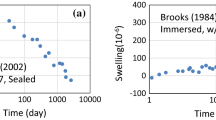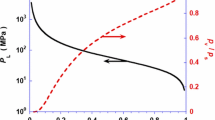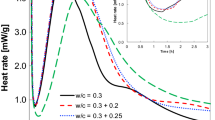Abstract
Recent advances in physical understanding of creep and shrinkage of cement paste suggest a novel approach to setting and hardening processes. In high-strength concrete, due to a low water-cement ratio, self-desiccation occurs immediately after setting, and capillary pressure produces compaction of the assembly of hydrating cement grains. For higher watercement ratio, water possibly can withstand cavitation, but then the volumetric balance of hydration requires that water move through the solid skeleton. According to Darcy's law, water only can be displaced by a gradient of hydraulic pressure, as long as the water pressure remains lower than its cavitation threshold. This water pressure only can be equilibrated by a compaction of the solid matrix, with compressive contacts particularly between the C-S-H layers. In both cases, with or without liquid-gas menisci, hydration acts like a distributed pumping of water, the liquid phase is under tension, and the solid skeleton is compressed. The high affinity of C-S-H for water and the viscoplastic behavior of the cement gel can explain the evolution of the contact between two hydrating cement grains and the formation of a continuous and cohesive bridge. Swelling and shrinkage then can be analyzed as two co-existing mechanisms, whose balance is controlled by the permeability of the solid matrix.
Résumé
Les progrès accomplis récemment dans la compréhension des mécanismes de retrait et de fluage des matériaux à base de ciment apportent un nouvel éclairage sur les processus de prise et de durcissement du ciment. Dans les bétons de haute résistance, les faibles rapports eau/ciment conduisent, au cours de la prise, à une désaturation des pores qui engendre des tensions capillaries et une contrainte de compression au sein du squelette minéral. Au-dessus d'une certaine valeur du rapport eau/ciment, s'il n'y a pas cavitation, alors le déficit volumétrique de la réaction d'hydratation produit nécessairement des mouvements d'eau à travers le système granulaire, et des gradients de pression dans le liquide (loi de Darcy), donc des compressions dans l'empilement granulaire, notamment au niveau des contacts entre les grains de ciment. Même en l'absence de tout ménisque, il y a des tensions dans la phase liquide, donc des compressions dans le squelette granulaire. La compréhension que nous avons aujourd'hui du comportement viscoplastique du gel des C-S-H permet d'expliquer comment le contact entre deux grains hydratants peut se transformer en un pont continu et cohésif. Retraits et gonflements apparaissent ainsi comme deux conséquences de l'hydratation, dont la résultante est contrôlée par la perméabilité (décroissante) du squelette.
Similar content being viewed by others
References
Le Chatelier, H., ‘Sur les changements de volume qui accompagnent le durcissement des ciments’,Bulletin de la Société pour l'Encouragement de l'Industrie Nationale, 5e Série, t. 5 (1900) 54–57.
Powers, T.C. and Brownyard, T.L., ‘Studies of the physical properties of hardened Portland cement paste’,Research Laboratories of the PCA, Bulletin 22 (1948).
Justnes, H., Sellevold, E.J., Reyniers, B., Van Loo, D., Van Gemert, A., Verboven, F. and Van Gemert, D., ‘The influence of cement characteristics on chemical shrinkage’, Proceedings of the International Workshop on ‘Autogenous Shrinkage of Concrete’, Hiroshima (1998) 67–76.
Barcelo, L., Boivin, S., Acker, P., Toupin, J. and Clavaud, B., ‘Early age shrinkage of concrete: back to physical mechanisms’,Concrete Science and Engineering 3 (10) (2001) 85–91.
Acker, P., Baroghel-Bouny, V. and Garcia-Boivin, S., ‘Can water be the glue?’, Proceedings of ‘Why does cement set?— An interdisciplinary approach’, 2nd RILEM Workshop on ‘Hydration and setting’, Dijon (1997) 23–36.
Miyazawa, S. and Monteiro, P.J.M., ‘Volume change of high-strength concrete in moist conditions’,Cement and Concrete Research 26 4 (1996) 567–572.
Wittmann, F.H., ‘Surface tension, shrinkage and strength of hardened cement paste’,Mater. Struct. 6 (1968) 547–552.
Baroghel-Bouny, V. and Kheirbek, A., ‘Effect of mixparameters on autogenous deformations of cement pastes’, Proceedings of RILEM Symposium ‘Shrinkage 2000’, Eds V. Baroghel-Bouny and P.-C. Aïtcin, Paris (2000) 115–141.
Winslow, D.N., ‘The fractal nature of the surface of cement paste’,Cement and Concrete Research 15 (1985) 217–227.
Israelashvili, P., ‘Intermolecular and Surface Forces’ (Academic Press, London, 1985).
Jouanna, P. et Brocas, S., ‘Approche statistique du tenseur des contraintes par le viriel généralisé’,C. R. Acad. Sci. Paris, t. 329, Série II b (2001) 775–782.
Crassous, J., Charlaix, E. and Loubet, J.L., ‘Capillary condensation between high energy surfaces’,Europhys. Letter 28 (1) (1994) 37–42.
Baroghel-Bouny, V. and Chaussadent, T., ‘Pore structure and moisture properties of cement-based systems from water vapour sorption isotherms’, Proceedings of MRS 1994 Fall meeting, Vol. 370, Boston (1995) 245–254.
Acker, P., ‘Micromechanical analysis of creep and shrinkage mechanisms’, in Ulm, F.-J., Bažant, Z.P. and Wittmann F.H. (eds.), ‘Creep, shrinkage and durability mechanics of concrete and other quasi-brittle materials’ (Proceedings of ConCreep-6@MIT), ELSEVIER, London, (2001) 15–25.
Constantinides, G., Ulm, F.-J. and Van Vliet K., ‘On the use of nanoindentation for cementitious materials’,Mater. Struct. 36 (2003) 191–196.
Acker, P., Boulay, C. and Rossi, P., ‘On the importance of initial stresses in concrete and of the resulting mechanical effect’,Cement and Concrete Research 17 (5) (1987) 755–764.
Roelfstra, P.E., Sadouki, H. et Wittmann F.H., ‘Le béton numérique’,Mater. Struct. 18 (107) (1985) 327–335.
Velez, K., Maximilien, S., Damidot, D., Fantozzi, G. and Sorrentino, F., ‘Determination by nanoindentation of elastic modulus and hardness of pure constituents of Portland cement clinker’,Cement and Concrete Research 31 (2001) 555–561.
Le Roy, R. et Granger, L., ‘Calcul du fluage propre du béton à partir de celui de la pâte de ciment’ (‘Assessment of basic creep of concrete as deduced from the creep of cement paste’)Bulletin des Laboratoires des Ponts et Chaussées, No 196 (1995) 67–78
Gopalakrishnan, K.S., Neville, A.M. and Gahli, A., ‘Elastic and time-dependent effects of aggregate-matrix interaction’,Mater. Struct. 16 (1970) 225–236.
Acker, P. and Ulm, F.-J., ‘Creep and shrinkage of concrete: physical origins and practical measurements’,Nuclear Engineering and Design 203 (2001) 143–158.
Ouaguenouni, S. and Roux, J.-N., ‘Force distribution in frictionless granular packings at rigidity threshold’,Europhysics Letters 39 (1997) 117–122.
Author information
Authors and Affiliations
Additional information
Editorial Note Prof. Paul Acker is a RILEM Senior Member.
Rights and permissions
About this article
Cite this article
Acker, P. Swelling, shrinkage and creep: a mechanical approach to cement hydration. Mat. Struct. 37, 237–243 (2004). https://doi.org/10.1007/BF02480632
Received:
Accepted:
Issue Date:
DOI: https://doi.org/10.1007/BF02480632




